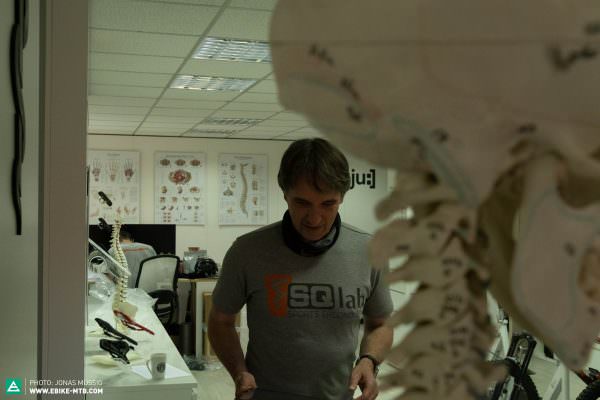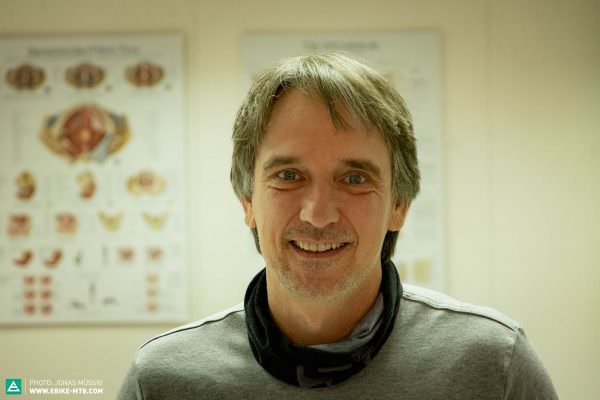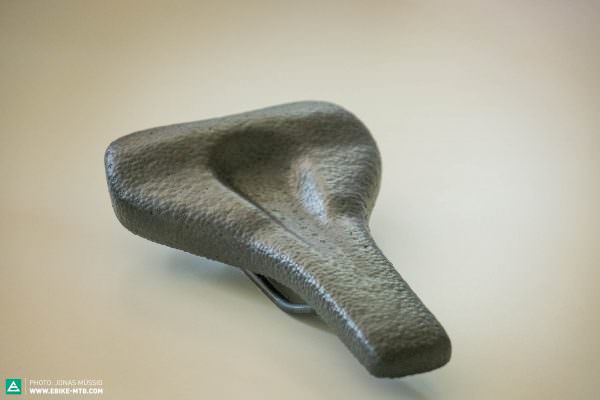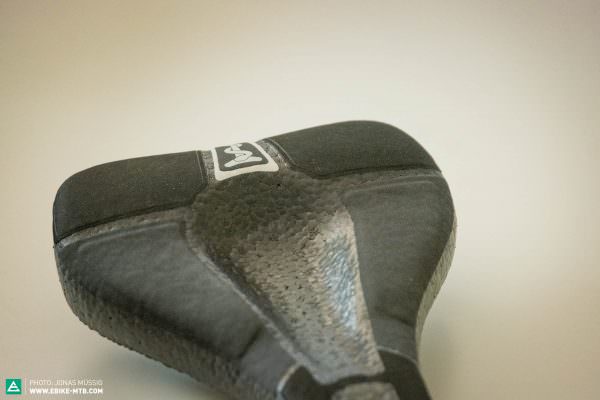SQlab are one of the most renowned brands when it comes to ergonomics on the bike. We met with managing director Tobias Hild at the company’s headquarters in Taufkirchen and gained important insights into the development and production of their latest product: a comfortable saddle that is 100% made in Germany.

E-MOUNTAINBIKE: Toby, before we get into the topic of “Made in Germany”, can you tell us what motivated you to found SQlab?
I had my first company very early on when I was still riding motocross and downhill. At that time, we were still learning from motocross and picking up tricks to develop better components for downhillers, like better handlebars. Unfortunately, at the time I suffered an injury. It was only after some time that I was able to start riding again, but I quickly started experiencing numbness. This led to my interest in ergonomics. I was already acquainted with our bike-savvy urologist Dr Stefan Staudte and when we first talked about my numbness, it became clear pretty quickly that detailed knowledge of anatomy can help make products to solve such problems, no matter whether it’s numb fingers, a numb genital area or back problems. I found the challenge exciting. The fire was lit and we quickly discovered that sit bone distance is the decisive criterion when choosing a saddle to avoid problems with numbness. No one had really considered this before, so we developed our own measuring system for saddles. Actually, it’s just as simple as for shoes. Nobody would think of buying shoes in the wrong size but with saddles, that’s exactly what everyone did. Saddle size depends on the distance between the sit bones and that has to be measured beforehand.


It’s like shoes. You don’t buy them in the wrong size. So why would you with a saddle?
E-MOUNTAINBIKE: So your personal story has become a clear vision for the SQlab company! Can you briefly take us on the rest of the journey and explain what the brand is all about?
It’s a mixture of coincidence, acquaintances, my personal history and passion that has shaped the brand. And no clear business plan. When we developed the first saddle and the measuring system, the feedback we got was great. People understood the benefits pretty quickly. From then on it became clear that I wanted my company to continue contributing to solving ergonomic problems in the future. We already knew that it doesn’t stop at the saddle but that anatomical knowledge can be used to improve the overall ergonomics of the bike. That’s why we also have grips, handlebars, stems, pedals, trousers and, actually, anything that has to do with contact points on the bike.
E-MOUNTAINBIKE: You launched a “Made in Germany” project in which you developed and manufactured a saddle 100% in Germany. How did this come about and how did you approach it?
For several years now, we have made a point of finding partners in Germany for our projects who take on manufacturing for us. As a German company, it has advantages for our processes and procedures to have not only development but also manufacturing in Germany. Sustainability and transportation are also issues we are concerned with and would like to work more on in the long term. Really, we’ve been looking for the ideal opportunity to do such a project for a long time. The starting point for the new SQlab saddle, which is made entirely in Germany, was a relatively new material called expanded thermoplastic polyurethane (E-TPU) that was developed by BASF. It is very elastic, super resilient and abrasion-resistant, and has already been able to prove itself in other areas such as sports shoes. The material’s properties allow us to create more comfortable saddles than we have been able to do so far. The choice of material for saddles is often dependent on resistance to deformation. You can imagine it like the rebound of a suspension fork. If the fork rebounds too slowly, the suspension travel can no longer be used effectively because the fork sinks deeper and deeper into its travel. It’s similar for a saddle. With repeated shocks, the material must rebound quickly enough and return to its original shape, otherwise, any comfort quickly disappears. The special E-TPU material, called Infinergy by BASF, meets all our needs in terms of material properties.


E-MOUNTAINBIKE: Are there also limitations with the new material?
Yes, one small one. We have to stick to certain minimum thicknesses when it comes to manufacturing. This is no problem for our 60X Ergowave model, which is specially designed for eMTBs and trail and enduro use. However, for our 610, 611 and 612 saddles we can’t yet use the material. At least not in a way that would offer only advantages.
E-MOUNTAINBIKE: What are the challenges and advantages of a product that is made in Germany?
Short distances and fast response times are a real bonus in terms of efficiency. In particular, during development, we can respond more quickly if any problems arise or we discover something during testing. Of course, there’s also an environmental advantage. But there are also challenges, especially when it comes to manufacturing and automation. As a brand in the bike industry, it is not at all easy to find suitable, highly qualified and motivated partners in Germany. For our project, we had to bring together the best people in material research and manufacturing in the field. We’ve found in the past that you often end up competing with the automotive industry. For a long time, the latter was the more interesting sector for many experts. On top of that, a saddle often still requires manual labour to produce. However, that would be far too expensive in Germany, so we had to automate saddle production with the new technology and find suitable partners to do so – a long but exciting process. The bike boom was a door opener for us, opening up new opportunities and possibilities. People simply want to go and ride. This made it much easier for us to initiate collaborations and to finally realise the project we had been planning for a long time. With Oechsler, a company in Ansbach, we’ve found a partner who already has experience working with the Infinergy material and is highly motivated to work with us to develop novel technology for saddle production.


The important thing is to keep increasing comfort with new technologies.


E-MOUNTAINBIKE: What does that mean for customers? What are the benefits for them? Will they have to pay significantly more for the saddle because it is made in Germany?
We’ve managed to automate many steps in our process without reducing quality compared to manual construction. As a result, the new SQlab 60X Infinergy Ergowave active 2.1 saddle, which is 100% made in Germany, costs just €50 more than the previous model, which was made in Asia. However, our eMTB and gravity bike customers are spending their money not just on the environmental benefit and increased comfort through the Infinergy material, but also on the new active system, which activates the intervertebral discs even better than before.


E-MOUNTAINBIKE: You have your own test lab and your own research and development department. How did the development of the new SQlab 60X saddle happen?
Naturally, we test a lot, in the laboratory as well. On the one hand, to comply with DIN standards but also to be able to demonstrate what advantages individual development processes and the final product have with figures, diagrams and videos. For example, we can easily measure how the new active system activates the intervertebral discs even better than before. In addition, the videos help us to explain our approach and the advantages of our products. However, ultimately the products have to work in the real world. That’s why testing things on the trail is just as important to us as our lab tests. In addition to offering technological features, the products also have to deliver in practice. For us, combining both types of tests cleverly is the means to success, because the degree of innovation on offer must provide an advantage. What matters to us is that the innovation really is an innovation. After all, it’s no use if a new saddle is more expensive and heavier, yet offers less comfort on top of that.
Innovation for innovation’s sake is not our goal. A new product must always deliver clear benefits.


E-MOUNTAINBIKE: Can you give our readers any tips on what they should definitely pay attention to when buying a saddle?
Yes, of course. The first thing is always to get your measurements, otherwise the saddle won’t fit. Another common issue is the perineal area in men and the pubic arch in women. These areas need to be relieved of pressure. Many people still think that a soft, thick and evenly padded saddle is the key to success, but exactly the opposite is the case. If the saddle is evenly padded, there is usually also even pressure here. As a result, everything in this region becomes numb and numbness is always bad. Many people ignore it because nothing hurts, but numbness always indicates a circulatory issue and that’s bad if you want to remain sexually active. If you sit on a saddle and feel your sit bones, that’s a good sign. For many, this is unfamiliar at first and sometimes takes three to four rides to get used to. The important message is that numbness is always bad and you should definitely act on it.
The important message is that numbness is always bad and you should definitely act on it.
E-MOUNTAINBIKE: Do men and women need different saddles?
No, that’s a misconception. Of course, if you look at the anatomy of women and men in the pelvic area it is very different. If you choose the saddle width based on the distance between the sit bones, the differences between male and female bikers are small. The areas that touch the saddle have little to do with gender. The biggest differences are in the perineal area, and here you can best reduce pressure for both sexes with the same saddle shape.
E-MOUNTAINBIKE: Finally, can you give us a preview of any upcoming projects? Does your “Made in Germany” project mean that even more SQlab products will be manufactured in Germany in the future?
Yes, as mentioned at the beginning, we’ve been interested in German service providers and collaboration partners for manufacturing for quite some time. With this first “Made in Germany” project, which we’ve been able to implement successfully, we’ve reached a milestone that we want to build on in the future. Further saddles and grips that are made in Germany are in the pipeline, but it’s still a little too early to talk about them in detail. We’re also currently cooperating with a partner from Switzerland. The goal is to produce a saddle completely from carbon with a fully automated process.
E-MOUNTAINBIKE: Thank you, Toby, for your insights, your time and the interesting conversation!
Fore more information, visit sq-lab.com
Did you enjoy this article? If so, we would be stoked if you decide to support us with a monthly contribution. By becoming a supporter of E-MOUNTAINBIKE, you will help secure a sustainable future for high-quality cycling journalism. Click here to learn more.
Words & Photos: Jonas Müssig









